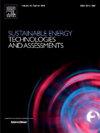具有行驶条件频率分布特征的混合动力电动汽车能耗优化计算方法
IF 7.1
2区 工程技术
Q1 ENERGY & FUELS
Sustainable Energy Technologies and Assessments
Pub Date : 2024-11-19
DOI:10.1016/j.seta.2024.104083
引用次数: 0
摘要
针对串联式混合动力电动汽车在设计和优化过程中由行驶工况输入引起的一系列问题,如各种用户工况,可能会阻碍此类汽车的节能能力。工况构造不可避免地会导致信息丢失,而传统的设计方法需要很高的计算能力,在真实工况数据爆炸的情况下会遭遇时间灾难。本研究提出了一种具有行驶工况频率分布特征(DCFDCs)的工况表示方法和一种最优能耗计算方法,即具有 DCFDCs 的瞬时电池能量平衡求解和全局电池能量平衡校正(IBGB-GBEB)。能耗计算结果表明,所提出的最优能耗计算方法既能保证能耗计算的准确性,又能降低计算时间成本。最优能耗法与动态规划(DP)算法的燃料消耗量仅相差 2.50%,但两种方法的计算时间相差 87.00%。此外,混合动力系统(HPS)设计参数优化的实际例子表明,TDCR-DP 和 DCFDCs-MIGA 方法得到的能耗计算结果是一致的,相对误差仅为 1.81%。然而,TDCR-DP 方法的计算时间为 472 h,而 DCFDC-MIGA 方法的计算时间仅为 2.17 h,计算时间缩短了 99.54% 以上。结果凸显了采用 DCFDC 的最优能耗计算方法的有效性和时间优势。该研究可为解决因行驶状态数据爆炸而引起的系统优化问题提供理论指导和技术支持。本文章由计算机程序翻译,如有差异,请以英文原文为准。
An optimal energy consumption calculation method of hybrid electric vehicles with frequency distribution characteristics of driving conditions
For a series of problems in the design and optimisation of series hybrid electric vehicles caused by the driving condition input, such as a variety of user conditions, which may hinder the energy-saving ability of such vehicles. Condition construction will inevitably lead to information loss, and traditional design methods require high computational power and encounter a time disaster during the real-world condition data explosion. This study proposes a condition representation method with driving condition frequency distribution characteristics (DCFDCs) and an optimal energy consumption calculation method, that is, instantaneous battery energy balance solution and global battery energy balance correction (IBGB–GBEB) with DCFDCs. The energy consumption calculation results show that the proposed optimal energy consumption method can guarantee the accuracy of the energy consumption calculation and reduce the calculation time cost. The difference in fuel consumption between the optimal energy consumption method and the dynamic planning (DP) algorithm is only 2.50%, but the difference in the calculation time between the two methods is 87.00%. Furthermore, the practical example of hybrid power system (HPS) design parameter optimisation shows that the energy consumption calculation results obtained by the TDCR–DP and DCFDCs–MIGA methods are consistent, and the relative error is only 1.81%. However, the calculation time of the TDCR–DP method is 472 h, whereas that of the DCFDC–MIGA method is only 2.17 h, which is a calculation time reduction of more than 99.54%. The results highlight the effectiveness and time advantage of the optimal energy consumption calculation method with DCFDCs. This study can provide theoretical guidance and technical support for solving system optimisation problems caused by the explosion of driving condition data.
求助全文
通过发布文献求助,成功后即可免费获取论文全文。
去求助
来源期刊

Sustainable Energy Technologies and Assessments
Energy-Renewable Energy, Sustainability and the Environment
CiteScore
12.70
自引率
12.50%
发文量
1091
期刊介绍:
Encouraging a transition to a sustainable energy future is imperative for our world. Technologies that enable this shift in various sectors like transportation, heating, and power systems are of utmost importance. Sustainable Energy Technologies and Assessments welcomes papers focusing on a range of aspects and levels of technological advancements in energy generation and utilization. The aim is to reduce the negative environmental impact associated with energy production and consumption, spanning from laboratory experiments to real-world applications in the commercial sector.
 求助内容:
求助内容: 应助结果提醒方式:
应助结果提醒方式:


